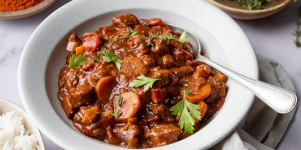You are using an out of date browser. It may not display this or other websites correctly.
You should upgrade or use an alternative browser.
You should upgrade or use an alternative browser.
Opinion on Goulash
- Thread starter Mark Belgrum (Dutch)
- Start date
Title: The Culinary Delight of Goulash: An Exploration of Opinions, Origins, and Variations
Introduction
Goulash, a hearty stew originating from Hungary, has captivated the palates of food enthusiasts worldwide. Its rich history, flavorful ingredients, and diverse interpretations have made it a beloved dish. In this essay, we will delve into the multifaceted world of goulash, discussing its origins, its various forms across different cultures, and the myriad opinions that surround it.
Origins of Goulash
Goulash, also spelled "gulyás" in its original Hungarian form, has its roots in the Hungarian countryside. This robust dish was first concocted by Hungarian cattle herders, known as "gulyás" or "gulyások," during the 9th century. The herders would prepare goulash in large cauldrons over open fires using readily available ingredients such as beef, paprika, and other spices. This humble beginning reflects the pragmatic nature of goulash as a nourishing and easily transportable meal for the pastoral lifestyle.
Opinions regarding the authenticity of goulash often hinge on these historical origins. Some purists argue that only the original Hungarian goulash, prepared with specific ingredients and traditional cooking methods, can be considered genuine goulash. Others, however, embrace the dish's evolution and welcome its adaptation to different palates and culinary cultures.
The Diverse World of Goulash Variations
As goulash traveled beyond Hungary, it underwent a myriad of transformations. Different regions and countries adapted the basic concept of goulash to their local tastes, creating a fascinating mosaic of goulash variations.
Goulash's adaptability and ever-evolving nature have given rise to a broad spectrum of opinions and debates surrounding the dish. Below are some key points of contention in the world of goulash:
Beyond its culinary significance, goulash has also left its mark on popular culture. It has been featured in literature, film, and television, often as a symbol of comfort and nostalgia. Its presence in these mediums has further contributed to the diverse opinions about the dish.
In literature, goulash has been a recurring theme in various novels, showcasing its role as a hearty and satisfying meal. It often symbolizes the importance of sharing food with loved ones and serves as a source of comfort in times of hardship.
In film and television, goulash frequently appears as a dish that brings people together. Whether in a family gathering, a cozy dinner date, or a communal event, goulash embodies the idea of food as a unifying force, transcending cultural boundaries and differences.
The portrayal of goulash in popular culture serves to underscore the emotional and nostalgic connections people have with the dish. It reinforces the notion that goulash is not just a meal but a source of warmth, tradition, and togetherness.
Introduction
Goulash, a hearty stew originating from Hungary, has captivated the palates of food enthusiasts worldwide. Its rich history, flavorful ingredients, and diverse interpretations have made it a beloved dish. In this essay, we will delve into the multifaceted world of goulash, discussing its origins, its various forms across different cultures, and the myriad opinions that surround it.
Origins of Goulash
Goulash, also spelled "gulyás" in its original Hungarian form, has its roots in the Hungarian countryside. This robust dish was first concocted by Hungarian cattle herders, known as "gulyás" or "gulyások," during the 9th century. The herders would prepare goulash in large cauldrons over open fires using readily available ingredients such as beef, paprika, and other spices. This humble beginning reflects the pragmatic nature of goulash as a nourishing and easily transportable meal for the pastoral lifestyle.
Opinions regarding the authenticity of goulash often hinge on these historical origins. Some purists argue that only the original Hungarian goulash, prepared with specific ingredients and traditional cooking methods, can be considered genuine goulash. Others, however, embrace the dish's evolution and welcome its adaptation to different palates and culinary cultures.
The Diverse World of Goulash Variations
As goulash traveled beyond Hungary, it underwent a myriad of transformations. Different regions and countries adapted the basic concept of goulash to their local tastes, creating a fascinating mosaic of goulash variations.
- Hungarian Goulash (Gulyás): The authentic Hungarian goulash remains popular both within Hungary and internationally. It consists of tender beef, potatoes, paprika, and an assortment of spices, creating a hearty and rich stew. Hungarian gulyás is often less thick and saucy than some of its counterparts.
- Goulash Soup (Gulyásleves): This is a variation within Hungary itself, where goulash is served as a soup, typically with smaller beef chunks and more emphasis on the broth. It is lighter and more soup-like than the traditional gulyás.
- American Goulash: In the United States, "American Goulash" is a distant cousin to the Hungarian original. This version usually includes ground beef, tomatoes, macaroni, and various seasonings. It is a comfort food that has found a place in many American households, albeit with a distinct flavor profile.
- Czech Goulash (Hovězí Guláš): The Czech Republic has its own version of goulash, known as hovězí guláš, which features beef, onions, paprika, and caraway seeds. It is often served with bread dumplings.
- German Goulash (Gulasch): German goulash is characterized by the use of pork or beef, onions, bell peppers, and a rich, thick gravy. It's commonly served with noodles or potatoes.
- Austrian Goulash (Wiener Saftgulasch): In Austria, Wiener Saftgulasch is famous for its tender beef, onions, and a dark sauce flavored with paprika, often served with dumplings or bread.
- Transylvanian Goulash (Gulyás): Transylvania, now part of Romania, has its own take on goulash. It typically includes pork, beef, or even mutton, along with paprika and other spices. It's known for its robust and spicy flavor.
- Vegetarian and Vegan Goulash: For those who prefer a plant-based diet, vegetarian and vegan goulash options are available, often using ingredients like mushrooms, lentils, and a variety of vegetables to replicate the flavors of traditional goulash.
Goulash's adaptability and ever-evolving nature have given rise to a broad spectrum of opinions and debates surrounding the dish. Below are some key points of contention in the world of goulash:
- Authenticity: As mentioned earlier, the debate over what constitutes "authentic" goulash is a common point of contention. Purists argue that only the original Hungarian gulyás can lay claim to the title of true goulash, while others embrace the diversity of interpretations.
- Variations and Cultural Adaptations: Some see the wide array of goulash variations as a testament to the dish's versatility and global appeal. They appreciate how different regions have incorporated local ingredients and culinary traditions into their versions of goulash.
- Taste Preferences: The flavor profile of goulash varies significantly from one version to another. While some prefer the robust and spicy flavors of Transylvanian goulash, others lean towards the milder American goulash. Personal taste plays a pivotal role in shaping one's opinion on goulash.
- Historical Significance: Goulash has a significant historical importance in Hungary. For many, it is more than just a dish; it's a symbol of cultural identity and a connection to their ancestors. This historical and cultural significance can influence people's opinions about how goulash should be made and appreciated.
- Culinary Creativity: Goulash's adaptability has inspired culinary creativity. Chefs and home cooks often put their own twists on goulash, experimenting with ingredients, spices, and cooking methods. For some, this experimentation is celebrated, while others may view it with skepticism.
- Simplicity vs. Complexity: Traditional Hungarian gulyás is known for its simplicity, while other variations can be more complex in terms of flavors and ingredients. Opinions differ on whether goulash should remain a rustic, straightforward dish or be explored as a canvas for gastronomic innovation.
- Cultural Appreciation: Many argue that the various goulash interpretations are an opportunity to appreciate and celebrate different cultures and their unique culinary traditions. In this sense, goulash becomes a bridge between diverse societies.
Beyond its culinary significance, goulash has also left its mark on popular culture. It has been featured in literature, film, and television, often as a symbol of comfort and nostalgia. Its presence in these mediums has further contributed to the diverse opinions about the dish.
In literature, goulash has been a recurring theme in various novels, showcasing its role as a hearty and satisfying meal. It often symbolizes the importance of sharing food with loved ones and serves as a source of comfort in times of hardship.
In film and television, goulash frequently appears as a dish that brings people together. Whether in a family gathering, a cozy dinner date, or a communal event, goulash embodies the idea of food as a unifying force, transcending cultural boundaries and differences.
The portrayal of goulash in popular culture serves to underscore the emotional and nostalgic connections people have with the dish. It reinforces the notion that goulash is not just a meal but a source of warmth, tradition, and togetherness.


 Platform Team
Platform Team Donator
Donator Senior Game Master
Senior Game Master